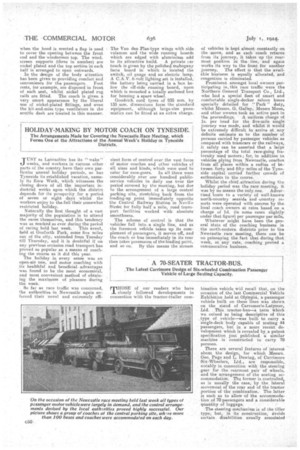A 70-SEATER TRACTOR-BUS.
Page 38

Page 39

If you've noticed an error in this article please click here to report it so we can fix it.
The Latest Carrimore Design of Six-wheeled Combination Passenger Vehicle of Large Seating Capacity.
WHOSE of our readers who have closely followed developments in connection with the tractor-trailer cam
bination vehicle will recall that, On the occasion of the last Commercial Vehicle Exhibition held at Olympia, a passenger vehicle built on these lines was shown on the stand of Carrosserie-Latermer, Ltd. This tractor-bus—a term which we coined as being descriptive of this type of vehicle—was built to carry a single-deck body capable of seating 44 passengers, but in a more recent development which is revealed by a patent specification just published a similar machine . is conetructed to carry 70 persons.
There are several features of interest about the design, for which Messrs. Geo. Page and L. Dewing, of Carrimore Six-Wheelers, Ltd., are responsible, notably in connection with the steering gear for the rearmost pair of wheels, and the arrangement of the seating accommodation. The former is controlled, as is usually the case, by the lateral movement. of the rear end of the tractor portion of -the .coinlaination. The latter is such as to allow of the accommodatian of 70 passengers and a considerable quantity of luggage.
The steering mechanism is of the tiller type; .but, in its construction, avoids certain disabilities usually associated with this form of gear. ,The tiller is short, being supplemented by coupling rods, which obviate the need for so long a tiller as is usually fitted, so that the risk of the tiller_ projecting outside the boundaries of the vehicle when on full lock is eliminated, as is that of its striking the underside of the trailer or the road when the bus is negotiating either a hillock or a depression in the road. With certain types of tiller gear, too, it is customary to arrange for the back axle and undercarriage to he dragged forward and pushed back under the full load of the trailer, by means of sliding bolsters, so that it can balance the relative movements of tractor and trailer when the steering gear is operating. The need for this is eliminated also in the peculiar construction embodied in this design.
The main controlling pin of the tiller gear is a long vertical one, depending from the rear end of the tractor, so that the tiller and all the coupling gear is low, thus allowing the trailer chassis to embody a well: Attached to the pin is a short telescopic tiller rod, the outer portion of which is suspended from 2, pivot carried by the frame of the trailer. This outer portion is T-shaped, and the ends of the crossbar are coupled by universally jointed and parallel rods to the rear turntable on which the back portion of the trailer is mounted.
The telescopic rod provides for any relative longitudinal movement between tractor and trailer, while the T-shaped connection has this special and favourable characteristic, that, while it is in its central position, it is most sensitive to movement of the tractor, and transmits that movement, in corresponding degree, to the rearmost axle, butt diminishes in effectiveness as the maximum lock of the front steering gear is reached. It lends itself,, too, to the embodiment of Ackerman-type steering gear for that rearmost axle, if such be desired. In such circumstances, the crossbar of the T-shaped lever may be equipped with bell-crank levers or some similar devices by which a variable movement will be given the two yoke rods, providing the differential action which is a characteristic of that form of steering gear.
It may be worth while to point out that in this gearthere is no operation oft the rear steering mechanism until the vehicle is actually moving, so that the inability to get away from the kerb sometimes experienced with rear-wheel steering machines will not occur.
The arrangement of the seats. can be gathered with some degree of accuracy by reference to the illustration at the top of this page. Accommodation for an upper deck, without exceeding a reasmiable limit of height, is available over the " well " portion of the trailer. In front of that the floor of the bus is higher, being reached by a couple of steps, as shown in the drawing. On the roof of this part accommodation is provided for luggage.
It must be clearly understood that this type of vehicle is not in production, but has merely been registered as a design, although its prototype, i.e., the tractorbus, with a single-deck body, has, as our readers are aware, already been manufactured.














































